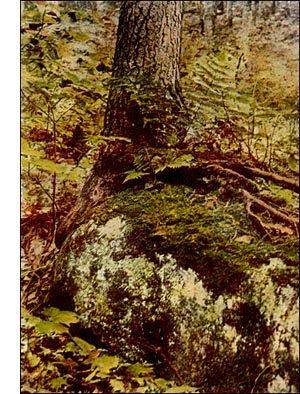Knights Plume Moss
 The Knight's Plume Moss, Hypnum (Ctenium) cristacastrensis, L.
The Knight's Plume Moss, Hypnum (Ctenium) cristacastrensis, L.Habit and habitat.-In loose, rigid, yellow-green tufts on decaying logs in mountainous regions.
Name.-The great Linnaeus named this pretty moss crista- castrensis from its resemblance to a military plume or crest-Latin crista, a crest, and castrensis, military.
Plant (gametophyte). -The stems prostrate, 3 to 5 inches long, the tips upright; simple or twice-branched, closely and regularly feather-branched, the branches resembling a fern frond; branchlets close, diverging horizontally and curved back at the apex like a plume.
Leaves.-Stem-leaves broad, gradually long lance-like and taper-pointed, thin, turned to one side as a scythe blade, with longitudinal folds ; vein double or none ;margin sharply serrate
from the middle upward.
Leaf-like organs (paraphyllia).-Numerous, long, narrowly lance-shaped.
Leaves at the base of the pedicel (peri-chaetial leaves).-Long, sheathing, white, veinless.
Habit of flowering.-Male and female flowers on separate plants (dioicous).
Veil (calyptra).-Thin, smooth, pointed and split up one side.
Spore-case.-Cylindrical-oblong, arched, green-brown when ripe, dirtyyellow when empty.
Pedicel (seta).-One-and-a-half to two inches long.
Lid (operculum). -Broadly conical, sharp-pointed.
Teeth (peristome).-The outer teeth orange below, pale, serrate, and awl-pointed above ; the inner teeth long-pointed and cleft ; cilia three or four, thick and as long as the teeth.
Annulus.-Simple and narrow.
Spores.-Mature in summer and autumn.
Distribution.-North America, Europe, Asia.